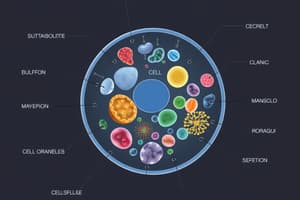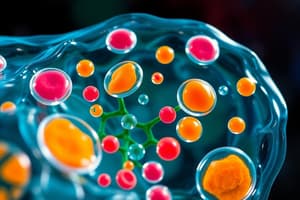Podcast
Questions and Answers
Which system is responsible for gas exchange in the body?
Which system is responsible for gas exchange in the body?
- Circulatory System
- Respiratory System (correct)
- Digestive System
- Nervous System
What is the primary function of the roots in plants?
What is the primary function of the roots in plants?
- Facilitate photosynthesis
- Support the plant structure
- Anchor and absorb nutrients (correct)
- Transport water
What is the process by which plants convert light energy into chemical energy?
What is the process by which plants convert light energy into chemical energy?
- Transpiration
- Fermentation
- Respiration
- Photosynthesis (correct)
Which of these is a characteristic of viruses?
Which of these is a characteristic of viruses?
What is genetic engineering primarily concerned with?
What is genetic engineering primarily concerned with?
Which system is primarily responsible for transporting blood and nutrients throughout the body?
Which system is primarily responsible for transporting blood and nutrients throughout the body?
What is a defining characteristic of prokaryotic cells?
What is a defining characteristic of prokaryotic cells?
Which organelle is known as the powerhouse of the cell?
Which organelle is known as the powerhouse of the cell?
What is the primary role of the Golgi apparatus?
What is the primary role of the Golgi apparatus?
In genetics, what does phenotype refer to?
In genetics, what does phenotype refer to?
What is the basic principle behind natural selection?
What is the basic principle behind natural selection?
What are biomes characterized by?
What are biomes characterized by?
What is the purpose of a Punnett square in genetics?
What is the purpose of a Punnett square in genetics?
Which structure carries genetic information in humans?
Which structure carries genetic information in humans?
Flashcards are hidden until you start studying
Study Notes
Cell Structure and Function
- Cell Theory: All living organisms are composed of cells; cells are the basic unit of life; all cells arise from pre-existing cells.
- Types of Cells:
- Prokaryotic: No nucleus, simpler structure (e.g., bacteria).
- Eukaryotic: Nucleus present, complex structure (e.g., plant and animal cells).
- Cell Organelles:
- Nucleus: Control center, contains DNA.
- Mitochondria: Powerhouse of the cell, site of ATP production.
- Ribosomes: Protein synthesis.
- Endoplasmic Reticulum (ER):
- Rough ER: Studded with ribosomes, synthesizes proteins.
- Smooth ER: Lipid synthesis, detoxification.
- Golgi Apparatus: Modifies, sorts, and packages proteins and lipids.
- Chloroplasts (in plant cells): Site of photosynthesis.
- Cell Membrane: Semi-permeable barrier that controls movement of substances.
Genetics
- DNA Structure: Double helix composed of nucleotides (adenine, thymine, cytosine, guanine).
- Chromosomes: Structures that carry genetic information; humans have 46 chromosomes (23 pairs).
- Genetic Inheritance:
- Mendelian Genetics: Principles of heredity; dominant and recessive traits.
- Punnett Squares: Tool to predict genetic variations.
- Phenotype vs. Genotype: Phenotype is the observable trait; genotype is the genetic makeup.
Evolution
- Theory of Evolution: Explains how species change over time through natural selection.
- Natural Selection: Process where organisms better adapted to their environment tend to survive and produce more offspring.
- Fossil Record: Provides evidence of historical life forms and evolutionary changes.
Ecology
- Ecosystem: A community of living organisms and their environment interacting as a system.
- Biomes: Large ecological areas with distinct climates and organisms (e.g., forests, deserts, grasslands).
- Food Chains and Webs:
- Food Chain: Linear flow of energy (producer → consumer → decomposer).
- Food Web: Complex interconnection of food chains.
- Biogeochemical Cycles: Cycles of elements (carbon, nitrogen, water) through living organisms and the environment.
Human Anatomy and Physiology
- Major Systems:
- Circulatory System: Transports blood and nutrients; consists of the heart and blood vessels.
- Respiratory System: Facilitates gas exchange; includes lungs and airways.
- Digestive System: Breaks down food into nutrients; includes stomach and intestines.
- Nervous System: Controls body activities; includes brain, spinal cord, and nerves.
Plant Biology
- Photosynthesis: Process by which plants convert light energy into chemical energy (glucose).
- Plant Structures:
- Roots: Anchor and absorb water and nutrients.
- Stems: Support and transport substances.
- Leaves: Primary site of photosynthesis.
Microbiology
- Bacteria: Single-celled prokaryotes; can be beneficial or pathogenic.
- Viruses: Non-cellular entities that require a host to replicate.
- Fungi: Decomposers; can be unicellular (yeast) or multicellular (mushrooms).
Biotechnology
- Genetic Engineering: Manipulation of an organism's DNA to improve or modify traits.
- Cloning: Creating a genetically identical copy of an organism.
- Stem Cell Research: Study of unspecialized cells that can develop into different cell types.
Cell Structure and Function
- Cell Theory: Core principles that all living organisms are made of cells; cells represent the fundamental unit of life; new cells originate from existing ones.
- Prokaryotic Cells: Characterized by the absence of a nucleus and simpler cellular structures, primarily represented by bacteria.
- Eukaryotic Cells: Possess a defined nucleus and more complex structures; examples include plant and animal cells.
- Nucleus: Acts as the control center of the cell, housing the genetic material (DNA).
- Mitochondria: Known as the cell's powerhouse, these organelles play a crucial role in ATP production, the energy currency of the cell.
- Ribosomes: Essential for protein synthesis; can be found free in the cytoplasm or attached to the rough endoplasmic reticulum.
- Endoplasmic Reticulum (ER):
- Rough ER: Has ribosomes on its surface, focuses on synthesizing proteins.
- Smooth ER: Functions in lipid synthesis and detoxification processes.
- Golgi Apparatus: Responsible for modifying, sorting, and packaging proteins and lipids for delivery to their destinations.
- Chloroplasts: Unique to plant cells, these organelles are the site of photosynthesis, converting sunlight into chemical energy.
- Cell Membrane: A semi-permeable barrier that regulates the entry and exit of substances in and out of the cell.
Genetics
- DNA Structure: Formed as a double helix, composed of nucleotide units (adenine, thymine, cytosine, guanine) that store genetic instructions.
- Chromosomes: Structures that organize DNA; humans have a total of 46 chromosomes arranged in 23 pairs.
- Mendelian Genetics: Principles governing heredity and the inheritance of traits, distinguishing between dominant and recessive characteristics.
- Punnett Squares: Graphical tools utilized to forecast genetic variations and inheritance outcomes.
- Phenotype vs. Genotype: The phenotype refers to the physical expression of traits, while the genotype denotes the underlying genetic constitution.
Evolution
- Theory of Evolution: Provides an explanation for the gradual change of species over time through the mechanism of natural selection.
- Natural Selection: A process in which organisms that are better suited to their environment are more likely to survive and reproduce.
- Fossil Record: Serves as empirical evidence of historical life forms and the evolutionary transformations they underwent.
Ecology
- Ecosystem: An integrated system of interacting living organisms and their physical environment.
- Biomes: Distinct ecological regions characterized by specific climates and communities of flora and fauna, such as forests, deserts, and grasslands.
- Food Chains and Webs:
- Food Chain: Represents the linear flow of energy through a sequence of organisms (producers, consumers, decomposers).
- Food Web: A more complex network illustrating the interrelationships and food chains within an ecosystem.
- Biogeochemical Cycles: Describe the cyclical movement of essential elements (carbon, nitrogen, water) through biological and environmental systems.
Human Anatomy and Physiology
- Circulatory System: Transports blood, nutrients, and oxygen throughout the body; includes the heart and vascular network.
- Respiratory System: Facilitates the exchange of gases; primarily involves the lungs and airways.
- Digestive System: Responsible for breaking down food into absorbable nutrients; encompasses the stomach and intestines.
- Nervous System: Controls and coordinates body functions; consists of the brain, spinal cord, and peripheral nerves.
Plant Biology
- Photosynthesis: The transformative process in which plants convert light energy into chemical energy, primarily producing glucose.
- Plant Structures:
- Roots: Anchor plants and absorb essential water and nutrients from the soil.
- Stems: Provide support for the plant structure and facilitate the transport of nutrients and water.
- Leaves: The main sites where photosynthesis occurs, capturing sunlight for energy conversion.
Microbiology
- Bacteria: Microscopic single-celled prokaryotes with diverse roles, ranging from beneficial to pathogenic.
- Viruses: Non-living entities that cannot replicate independently; they rely on host cells for reproduction.
- Fungi: Act as decomposers in ecosystems; can exist as unicellular organisms like yeast or multicellular forms like mushrooms.
Biotechnology
- Genetic Engineering: The process of altering an organism's DNA to enhance or modify specific traits for practical applications.
- Cloning: Technique used to produce a genetically identical organism to a parent organism.
- Stem Cell Research: Focuses on studying undifferentiated cells capable of developing into various specialized cell types.
Studying That Suits You
Use AI to generate personalized quizzes and flashcards to suit your learning preferences.




